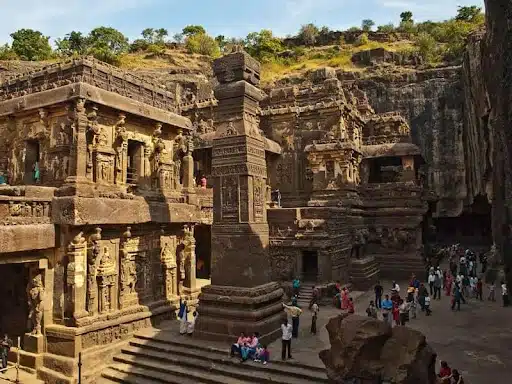About Ajanta and Ellora Caves
- Ajanta and Ellora caves, considered to be one of the finest examples of ancient rock-cut caves, are located near Aurangabad in Maharashtra.
- The Ajanta and Ellora cave complex is adorned with beautiful sculptures, paintings, and frescoes and includes Buddhist monasteries, Hindu and Jain temples.
- The Ajanta caves are 29 in number and were built between the 2nd century BC and the 6th century AD, whereas the Ellora caves are more spread out and 34 in number and date to the period between the 6th and 11th Centuries AD.
- Ajanta Caves are mostly Buddhist sites and were used as a retreat by Buddhist monks.
- The caves consisted of cells for meditation, assembly halls for discussions, and stupas for rituals.
- Ellora has a better mix of Hindu, Jain, and Buddhist structures.
- The caves are adorned with sculptures that reflect the spiritual beliefs of the time.
- The sculptures range from depictions of deities, celestial beings, and mythological scenes to portraits of royalty and everyday life.
- The Kailash Temple in Ellora is an architectural marvel. It is one of the largest monolithic structures in the world.
- The structure is carved vertically from a single rock. It took 18 years to carve out the temple.
- They are designated as UNESCO World Heritage Sites.
Key Facts about Swadesh Darshan Scheme
- It was launched in 2015 by the Ministry of Tourism, Government of India, to develop sustainable and responsible tourism destinations in the country.
- It is 100% centrally funded scheme.
- Under the scheme, the Ministry of Tourism provides financial assistance to State governments, Union Territory Administrations, or Central Agencies for development of tourism infrastructure in the country.
- Operation & Maintenance (O&M) of the projects sanctioned under the Swadesh Darshan Scheme is the responsibility of the respective State Government/UT Administration.
- Swadesh Darshan 2.0:
- The Ministry of Tourism has revamped its Swadesh Darshan scheme as Swadesh Darshan 2.0 (SD2.0) for the development of sustainable and responsible tourist destinations, covering tourism and allied infrastructure, tourism services, human capital development, destination management, and promotion, backed by policy and institutional reforms.
- The objective of the Swadesh Darshan 2.0 scheme envisages increase in private sector investment in tourism and hospitality.
- It may help in increasing Public Private Partnerships (PPP) in the field of tourism and operation and maintenance of the assets created under the scheme.
Q1) What are UNESCO World Heritage Sites?
A World Heritage Site (WHS) is a landmark or area with legal protection by an international convention administered by UNESCO under the UNESCO World Heritage Convention, established in 1972. These sites are designated by UNESCO for having cultural, historical, scientific or other forms of significance.
Last updated on December, 2025
→ Check out the latest UPSC Syllabus 2026 here.
→ Join Vajiram & Ravi’s Interview Guidance Programme for expert help to crack your final UPSC stage.
→ UPSC Mains Result 2025 is now out.
→ UPSC Notification 2026 is scheduled to be released on January 14, 2026.
→ UPSC Calendar 2026 is released on 15th May, 2025.
→ The UPSC Vacancy 2025 were released 1129, out of which 979 were for UPSC CSE and remaining 150 are for UPSC IFoS.
→ UPSC Prelims 2026 will be conducted on 24th May, 2026 & UPSC Mains 2026 will be conducted on 21st August 2026.
→ The UPSC Selection Process is of 3 stages-Prelims, Mains and Interview.
→ UPSC Result 2024 is released with latest UPSC Marksheet 2024. Check Now!
→ UPSC Prelims Result 2025 is out now for the CSE held on 25 May 2025.
→ UPSC Toppers List 2024 is released now. Shakti Dubey is UPSC AIR 1 2024 Topper.
→ UPSC Prelims Question Paper 2025 and Unofficial Prelims Answer Key 2025 are available now.
→ UPSC Mains Question Paper 2025 is out for Essay, GS 1, 2, 3 & GS 4.
→ UPSC Mains Indian Language Question Paper 2025 is now out.
→ UPSC Mains Optional Question Paper 2025 is now out.
→ Also check Best IAS Coaching in Delhi

















